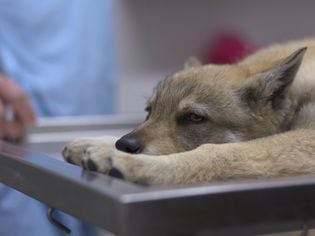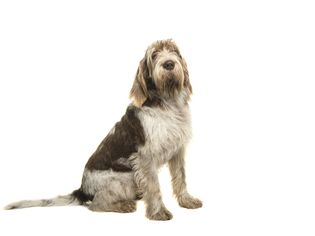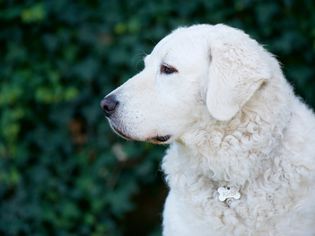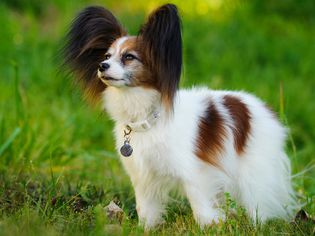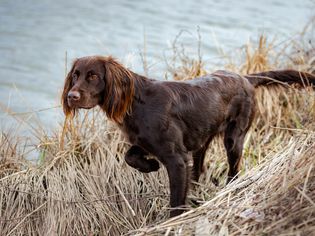The Rafeiro do Alentejo, also known as the Portuguese mastiff, Portuguese watchdog, or Alentejo Mastiff, is a large working dog from Portugal. This powerful, nocturnal breed is designed to work so while it can make a great farm dog, it's not well suited for a sedentary life in a small home.
Learn about the characteristics, history, and care needs of the Rafeiro do Alentejo.
Breed Overview
Group: Working
Height: 25-29 inches
Weight: 77-132 lbs
Coat: Short or medium-length straight fur
Coat Colors: Black, wolf grey, or fawn, may or may not have brindling but always has white markings or patches
Life Span: 12-14 years
Temperament: Calm, confident, powerful
Hypoallergenic: No
Origin Country: Portugal
Characteristics of the Rafeiro do Alentejo
This large dog breed has a short but thick coat and protective nature. Rafeiro do Alentejos were originally bred to hunt large game but over time they have been utilized to guard livestock and land. They are known to be calm, highly trainable and adaptable to various environments and schedules but are also have very strong protective instincts, making them a very loyal yet independent breed.
| Affection Level | High |
| Friendliness | Medium |
| Kid-Friendly | Medium |
| Pet-Friendly | Medium |
| Exercise Needs | Medium |
| Playfulness | Medium |
| Energy Level | Medium |
| Trainability | High |
| Intelligence | High |
| Tendency to Bark | Low |
| Amount of Shedding | Medium |
History of the Rafeiro do Alentejo
Thought to be bred from large mastiffs of the Middle East, the Rafeiro do Alentejo was originally designed to hunt in packs. They are adaptable and durable, which made them ideal companions for migratory shepherds and herds. This is what initially expanded their popularity in Portugal and when the shepherds began to settle down in the Alentejo plains, the breed hunted in packs less and instead became known for their ability to guard livestock and rural estates.
In 1953, the first breed standard was established but it gained worldwide popularity in 2023 when a supposed 30-year-old Rafeiro do Alentejo by the name of Bobi was awarded the Guinness World Record title of oldest dog. Bobi died when he was 31 years old, but the record was questioned for validity shortly thereafter.
Rafeiro do Alentejo Care
The difficulty in caring for the Rafeiro do Alentejo is low but like all dogs, this large Portuguese breed requires some exercise, grooming, and training to stay happy and healthy.
Exercise
The Rafeiro do Alentejo is meant to roam and cover large parcels of land. They are not designed to stay in small spaces for too long. Access to a large yard to walk or run in or being taken on multiple walks a day are the minimum amounts of exercise this breed needs. They are typically more active at night, so be prepared for nocturnal tendencies.
Grooming
This breed has short hair but a double coat, so regular brushing is required to maintain it. The Rafeiro do Alentejo doesn't require haircuts but regular nail trims and teeth brushings are needed. Occasional baths and ear cleanings will help keep your dog's skin healthy and clean but overall, this is a low-maintenance breed when it comes to grooming.
Training
Highly trainable but naturally protective, this smart breed will need consistent, positive-reinforcement training and socialization. With proper socialization and training, they can learn not only how to guard flocks but also become a friendly part of the family. These dogs are not suitable for first-time dog owners, and young children will need to be taught how to properly interact with them.
Common Health Problems
The Rafeiro do Alentejo is a fairly healthy breed, but no dog is completely free of any health issues. Some health problems that can occur in this large breed may include:
- Hip dysplasia
- Periodontal disease
- Ear infections
- Parasites
Diet and Nutrition
Like all dogs, the Rafeiro do Alentejo should eat a nutritionally complete diet formulated for dogs by veterinary nutritionists to thrive. This may be a store-bought kibble or a specially crafted diet. When feeding, measure out the appropriate amount of food based on your dog's weight, age, activity, and caloric content to prevent obesity and other health issues. If you aren't sure what or how much to feed, ask your veterinarian for recommendations.
If your Rafeiro do Alentejo is diagnosed with hip disease or tends to get recurrent ear infections, specific dietary additives like nutritional supplements may be recommended for additional support.
Where to Adopt or Buy a Rafeiro do Alentejo
This Portuguese dog breed is not very commonly found, especially outside of Portugal. Importation of this breed directly from Portugal may be necessary but the American Kennel Club (AKC) and local dog shows may also have recommendations for reputable breeders. Expect to pay a few thousand dollars for this rare breed, especially if you need to import a puppy.
Rafeiro do Alentejo Overview
Rafeiro do Alentejos can make excellent dogs for the right family and situation, however, you need to be fully prepared before bringing this dog into your home.
Pros of Rafeiro do Alentejos
- Loyal and calm
- Fairly quiet breed
- Low grooming needs
Cons of Rafeiro do Alentejos
- Can be wary of strangers due to protective instincts
- Requires space to roam
- Can be stubborn and hard to train
More Dog Breeds and Further Research
If you’re interested in breeds that are similar to the Rafeiro do Alentejo, check out:
- Pyrenean mastiff
- Anatolian shepherd
- Kuvasz
- Are Rafeiro do Alentejos aggressive?
While Rafeiro do Alentejos are great protectors, they are also calm and loyal. They are not aggressive unless they suspect something is threatening their flocks or family.
Are Rafeiro do Alentejos good family dogs?If socialized and trained from a young age, the Rafeiro do Alentejo can make a good family dog. They are very affectionate but will need training to be good with young children just as young children need to learn how to interact with dogs.
What were Rafeiro do Alentejos bred for?Initially Rafeiro do Alentejos were bred to hunt in packs but over time, their primary purpose changed. They demonstrated their ability to protect livestock as shepherd migrated earned them their place as respected guardian and working dogs.

